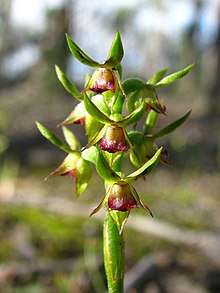Corunastylis ciliata
Corunastylis ciliata, commonly known as the fringed midge orchid, is a small terrestrial orchid endemic to southern Australia. It has a single thin leaf fused to the flowering stem and up to fifteen small, green to greenish yellow flowers with purplish markings and a reddish purple labellum. It was formerly included with Corunastylis archeri, and C. ciliata is regarded as a synonym of Genoplesium archeri by the World Checklist of Selected Plant Families.[2] Plants in this species have fewer, more erect flowers, a less-hairy labellum and have different coloration than C. archeri.
| Fringed midge orchid | |
|---|---|
 | |
| Scientific classification | |
| Kingdom: | Plantae |
| Clade: | Tracheophytes |
| Clade: | Angiosperms |
| Clade: | Monocots |
| Order: | Asparagales |
| Family: | Orchidaceae |
| Subfamily: | Orchidoideae |
| Tribe: | Diurideae |
| Genus: | Corunastylis |
| Species: | C. ciliata |
| Binomial name | |
| Corunastylis ciliata | |
| Synonyms[1] | |
|
Prasophyllum ciliatum Ewart & B.Rees | |
Description
Corunastylis ciliata is a terrestrial, perennial, deciduous, herb with an underground tuber and a single thin leaf 50–130 mm (2–5 in) and fused to the flowering stem with the free part 6–13 mm (0.2–0.5 in) long. Up to fifteen flowers are crowded along a flowering stem 5–30 mm (0.2–1 in) tall and taller than the leaf. The flowers are green to yellowish green with pale purple markings and are 8 mm (0.3 in) long and 5 mm (0.2 in) wide. As with others in the genus, the flowers are inverted so that the labellum is above the column rather than below it. The dorsal sepal is egg-shaped, about 4 mm (0.2 in) long and 2.5 mm (0.1 in) wide. The lateral sepals are linear to lance-shaped, about 5 mm (0.2 in) long, 1 mm (0.04 in) wide and spread apart from each other. The petals are lance-shaped to narrow egg-shaped, about 4 mm (0.2 in) long and 1.5 mm (0.06 in) wide with hairless edges and a pointed tip. The labellum is broadly elliptic to egg-shaped with the narrower end towards the base, 3–4 mm (0.1–0.2 in) long and 2–3 mm (0.08–0.1 in) wide with scattered hairs up to 0.5 mm (0.02 in) long on the edges. There is a tapered callus in the centre of the labellum and extending almost to its tip. Flowering occurs from February to April.[3][4]
Taxonomy and naming
The fringed midge orchid was first formally described in 1912 by Alfred Ewart and Bertha Rees and the description was published in the Proceedings of the Royal Society of Victoria.[5] In 1989 David Jones and Mark Clements changed the name to Corunastylis ciliata.[1] The specific epithet (ciliata) is from a Latin word cilium meaning "eyelash".[6]
Distribution and habitat
Corunastylis ciliata grows in heath, grassy woodland and heathy forest in Victoria mostly west of Wilsons Promontory. In South Australia it grows in moist places in or near swamps and is found on Mount Compass and Mount Gambier.[3][4]
References
- "Corunastylis ciliata". APNI. Retrieved 2 February 2018.
- "Corunastylis archeri". World Checklist of Selected Plant Families (WCSP). Royal Botanic Gardens, Kew.
- Jeanes, Jeff. "Corunastylis ciliata". Royal Botanic Gardens Victoria. Retrieved 2 February 2018.
- Jones, David L. (2006). A complete guide to native orchids of Australia including the island territories. Frenchs Forest, N.S.W.: New Holland. p. 179. ISBN 1877069124.
- "Prasophyllum ciliatum". APNI. Retrieved 2 February 2018.
- Brown, Roland Wilbur (1956). The Composition of Scientific Words. Washington, D.C.: Smithsonian Institution Press. p. 204.